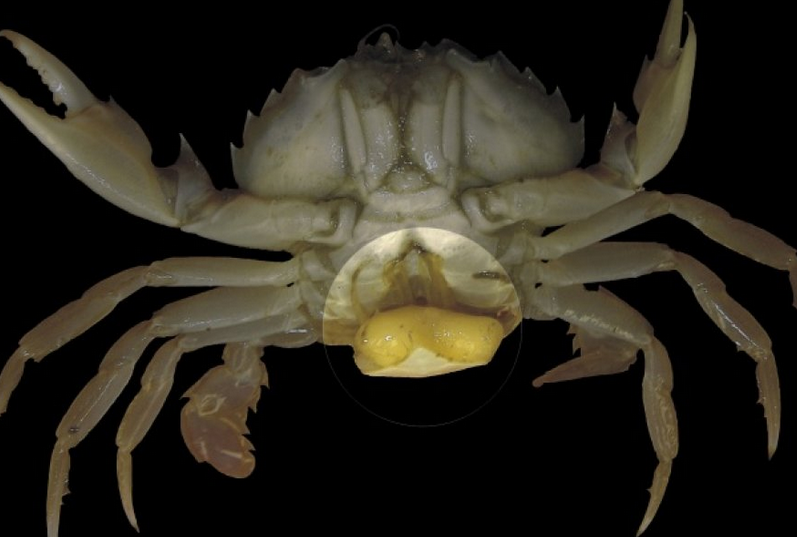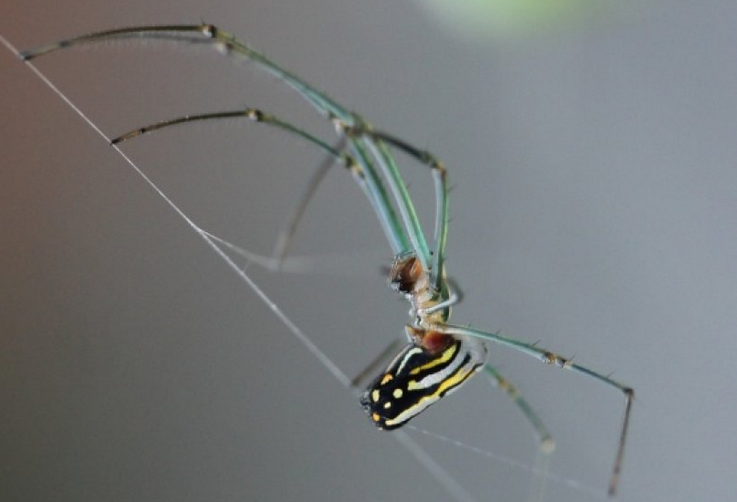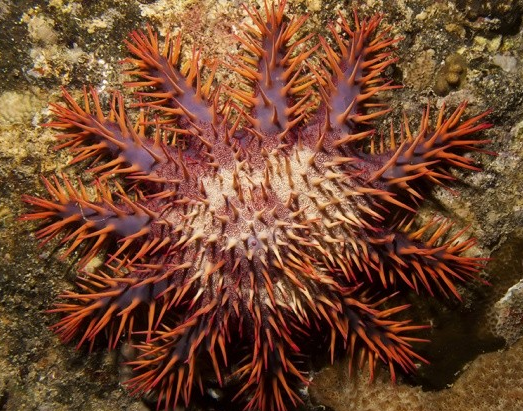5.雄性生育的海马
Most of us have mercifully forgotten the plot to the 1994 Schwarzenegger/DeVito vehicle "Junior." For the purposes of scientific edification, this article will do you the disservice of reminding you that it involves the future governor of California becoming pregnant. Hilarity ensues.
很多人已经大条地忘记了施瓦辛格和德维托主演的电影《威龙二世》中的故事情节。本着科普的目的,本文不怕死地提醒你这部电影讲述的是未来的加利福尼亚州州长怀孕的故事。男性怀孕?很好玩吧,接下来的内容更有趣。

Absurd concept, of course, but show this comedic gem to a seahorse, and it would shrug its shoulders (if it had them). And that's not because the film received a 32 percent rating on the Rotten Tomatoes review site, but rather because there's nothing surprising about pregnant males in the seahorse world. When seahorses get around to reproducing, the males and females engage in an elaborate, lengthy and apparently beautiful courtship dance in which they entwine their tails and swim in tandem. Eventually, with their movements fully synchronized, the female slips a couple thousand eggs into a little pouch the male has just for that purpose. The male fertilizes the eggs and carries them around in his pouch where they hatch. He carefully tends to their needs as they grow, and when they're ready to head off into the world he actually has muscular contractions to push them out. Meanwhile, the female has been getting some more eggs ready. Time to tango again! A male seahorse can give birth in the morning and be pregnant again by evening.
男性怀孕显然是一个脑洞大开的念头,但要是把这部喜剧片给海马看,他们最多无谓地耸耸肩。倒不是因为这部电影在烂番茄影评网的好评率只有32%,而是因为在海马界,雄性妊娠真的没什么可奇怪的。当海马们春心萌动想要繁衍后代时,雄海马和雌海马就会共舞一曲精致、悠长又美妙的求爱舞,他们的尾巴缠绕在一起,成双结对游来游去。待他们的舞步完全同步后,雌海马便会将两千个卵细胞滑入雄海马妊娠专用的育儿袋中。雄海马给这些卵细胞受精,并一直将受精卵放在体内用于孵化小海马的育儿袋中。他会悉心照料这些受精卵,尽力满足它们不同成长阶段的需求。当小海马们做好独自面对世界的准备时时,雄海马就会收缩育儿袋的肌肉,“生”出它们。与此同时,雌海马一直在为下次排卵做准备。又到了探戈时间!雄海马竟然可以上午“生”孩子,晚上就再次怀孕。
4.鸠占鹊巢的藤壶

And now for some creepy parasitic procreation! When it comes to parasites, it's hard to choose from the array of weird, brilliant and often really troubling modes of self-replication. However, a lowly barnacle called rhizocephalans has a strategy so Machiavellian it deserves some attention here.
现在让我们来看看寄生虫们可怕的繁衍方式。说到寄生虫,它们繁衍方式往往十分怪异,令人毛骨悚然还印象深刻。要从中挑选出更有特色的,还真的不容易。但是,一种不起眼的根头目甲壳动物藤壶,为了繁衍加不择手段,因而值得我们的关注。
Rhizocephalans — we'll call it rhizo for short — doesn't look like your ordinary barnacle. As a young larva, rhizo floats around in hopes of encountering a passing crab. Given the size of the ocean, the chances are slim, but rhizos are produced in vast quantities, so a few are bound to find their targets. Once a rhizo makes crab-fall, it latches on, develops a little syringelike appendage and injects its cells into the crab's system. The rhizo cells find their way to their host's sinus and there begin to grow a root system that spreads everywhere, eventually poking out in exactly the spot where a female crab would carry its eggs. The parasite then lays its own eggs there in a little sac. For reasons not yet fully understood, if the crab happens to be a male it will actually change shape, widening its abdomen to more closely resemble a female. Also unknown is how exactly the rhizo convinces its host that the parasitic eggs it's carrying around are actually crab eggs. Then, as though in a scene from "Being John Malkovich," the parasite directs its host out to deeper waters where it can avoid predators and competition for food. It's all a bit unsettling. But is it as disturbing as Hymenoepimecis argyraphaga? Read on to compare.
根头目甲壳动物藤壶,简称藤壶,与我们常见的藤壶在外观上并不相同。它们的幼虫在海面漂浮着,伺机遇到路过的螃蟹。大海茫茫,机会渺茫,但藤壶数量巨多,总有一些幼虫能找到它们的目标。藤壶一旦发现蟹群,就会立刻黏附在螃蟹身上,伸出像注射器的触手,把它的细胞注入螃蟹体内。藤壶细胞会聚集在螃蟹的窦道中,然后开始生根增长,到处扩散,最后在雌蟹的卵巢中探出头来,在螃蟹小小的腹部里产卵。如果藤壶寄居的恰巧是雄蟹,它们就会把雄蟹的腹部扩宽到跟雌蟹差不多大,而藤壶为什么这样做,人们也还没搞清楚。那么藤壶到底是怎么让螃蟹把它们的卵当成是自己的卵呢?人们也尚未得知。接着,就像电影《傀儡人生》中的情节一样,藤壶会操纵它的宿主去深水区孵卵,以躲避天敌捕食和减少食物竞争。这听起来真让人毛骨悚然。但这和寄生黄蜂的繁殖方式相比,简直小巫见大巫。不信就接着往下看吧!
3.谋“巢”害命的寄生蜂

Hymenoepimecis argyraphaga is a parasitic wasp that makes its home in lovely Costa Rica. When in the mood to reproduce, a female wasp hunts down a hapless spider by the euphonious name of Plesiometa argyra and paralyzes it for 10 or 15 minutes with a sting. In that quiet quarter of an hour the wasp lays an egg, gently attaches it to the spider's belly and departs.
在美丽的哥斯达黎加,有一种叫寄生黄蜂的寄生虫,当它想要繁殖时,雌蜂就会穷追不舍直至抓获一只蜘蛛,这种倒霉的蜘蛛有一个动听的名字叫Pleesiometa argyra。寄生蜂随后会用它的刺麻痹蜘蛛10到15分钟,在这蜘蛛失去知觉的这段时间里,寄生蜂会产下一颗卵,再轻轻地把它粘附在蜘蛛腹部然后离开。
When the spider recovers it goes about its business as though nothing has happened. Perhaps it doesn't remember; perhaps it doesn't want to remember. All the while that wasp egg is incubating. A week or two later, the intermission is over, and things go rapidly downhill for Plesiometa. The wasp larva hatches, stabs a hole in the spider's stomach and begins feeding off it. In a particularly diabolical move, the larva extracts one last resource from the spider before murdering it. The infant wasp injects some kind of psychoactive substance that convinces the poor thing to spin a very un-Plesiometa-like web. When it's done, the wasp kills the drug-addled arachnid, eats it and then uses the freshly spun web to wind itself into a cocoon. Less than two weeks later a fully grown Hymenoepimecis argyraphaga emerges, prepared to propagate in the same horrific way. Isn't nature wonderful?
蜘蛛恢复知觉后,就像什么都没发生过一样。或许它真的什么都不记得了,也或许它根本就不想记得。黄蜂的卵就一直这样静静地孵化着。一两个星期后,这种平静被打破,蜘蛛的处境急转直下。寄生黄蜂的幼虫孵化出来后,就用刺刺穿蜘蛛的胃,并从中取食。更丧心病狂的是,黄蜂幼虫在杀死蜘蛛前会将其榨取得一丝不剩。它向蜘蛛注射一种神经活性物质,诱惑其给它织一张形状完全不同于平时的新网。织完网后,黄蜂幼虫就会杀死蜘蛛并将它吃掉。接着把新织的网缠绕成一个茧,将自己包裹其中。不到两周的时间,黄蜂幼虫便可发育成熟,破茧而出。接着又准备重复这一惊悚的繁殖之路。大千世界无奇不有吧!
2.断肢再生的海星

If, like seahorses, starfish look like creatures from a fairytale, the venomous invertebrate known as the crown-of-thorns belongs in one of those old, sinister Brothers Grimm versions.
如果海星像海马一样,也是童话里才出现的生物,那么棘冠星鱼这种有毒的无脊椎动物,也只会出现在暗黑系的老旧格林童话版本中。
Crown-of-thorns starfish (or more properly, "sea stars") eat coral reefs. Because of human activities such as overfishing of their natural predators, they can sometimes undergo a population explosion. This, in turn, can result in the complete destruction of a reef. Not only will this mean the loss of habitat for the many creatures that make their home in reefs, but the local tourist industry can be hit too. To combat the problem, there have been various efforts the kill off the excess crown-of-thorns. On the Great Barrier Reef, for instance, divers started off by chopping the invertebrates into little pieces. The plan backfired because of the sea stars' remarkable ability to regenerate. Not only can they regrow lost limbs, but under the right circumstances, they can grow a whole new body from a severed limb. That's because their cells are "indeterminate," which means they retain the ability to form new body parts, just as our embryonic cells did when we were first developing. Now, if only we could master this regeneration thing — not only could we regrow lost limbs, we could generate whole new ones. Who couldn't use an extra pair of arms? Things would be a little weirder, though, if those disembodied arms grew a new you.
棘冠星鱼(称作“海洋之星”更为贴切)会吞食珊瑚礁。且由于过度捕捞它们的天敌等人类活动,导致这种海星时不时出现爆炸性增长,而珊瑚礁却因此遭受灭顶之灾。这不仅意味着许多依附珊瑚礁生活的生物将失去栖息地,对当地旅游业无疑也是沉重的打击。为了解决这一难题,人们尝试做出各种努力,意图消灭过量的海星。比如说在大堡礁,潜水员们把这些无脊椎动物砍成了一小片一小片的,希望这样可以杀死它们。然而事与愿违,这种海星的数量根本没有减少,因为它们有着可怕的再生能力 。它们不仅能使断肢重生,在合适的条件下,断肢甚至能再生成一个完整的全新的个体!因为它们的细胞具有高度全能性,就像我们人类生命形成之初的胚胎细胞一样,这意味着他们具有再生成新个体的能力。如今,我们若能掌控这种再生能力,那不仅能再生出身体受损的部位,甚至还能创造出一群全新的个体。谁不希望有三头六臂呢?然而,断掉的手臂就能长成一个崭新的自己,确实非常诡异!
1.调控性别的海金沙

Teenagers can procreate. Terrified by this prospect, their parents often seek to exert whatever control they can over their children's sex lives. From a teenager's perspective it's all rather annoying having old farts incessantly minding your business. But before sighing heavily and rolling your eyes at mom's intrusions, spare a thought for the Japanese climbing fern. Compared to them you've got it easy.
青少年已经具有生育能力了,父母们为了避免孩子们偷食禁果带来不良后果,总会想尽一切办法干涉孩子们的性生活。从青少年的角度来讲,也许你会觉得有一群不断干涉自己生活的长辈简直是世界上最闹心的事儿。在你哀叹不已,朝你那唠唠叨叨的老妈翻白眼之前,想想悲剧的海金沙,你就会暗自庆幸了。
Fully grown ferns are called gametophytes, and they can be males, females or hermaphrodites if there are no other breeders around to help out. But, of course, self-fertilization is the very incarnation of inbreeding, a situation to be avoided whenever possible. So, when little fernlings are growing, older females in the neighborhood can secrete a chemical called gibberellin, which causes the surrounding youth to turn into males. Thus the grown-ups control the gender balance to maintain a healthy genetic diversity. Of late, the word "community" has become a buzzword for all that is positive and necessary in 21st century life — perhaps the sex life of climbing ferns demonstrates that community involvement might have its limits!
完全成熟的蕨类植物被称作配子体,它们可以是雌性,也可以是雄性,甚至当周围环境没有配偶完成繁殖时,它们也可以是雌雄同体。但自体受精毕竟是近亲交配的一种形式,所以自然是要竭力避免的。因此,在海金沙幼苗成长的过程中,周围成熟的雌性植株会分泌一种名为赤霉素的化学物质,诱导这些幼秒生长成雄性植株。成熟的海金沙就通过这种方式调控性别平衡,维持群落内部合理的基因多样性。近来,“群落”、“社区”成为一个流行词,用来象征21世纪的生活中,那些带来正能量且为人们所需要的东西——然而海金沙的繁衍方式或许正揭示了社群生活也有其局限性。

















